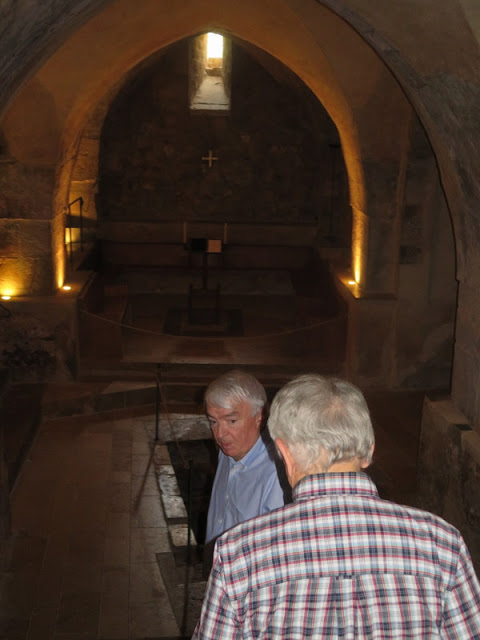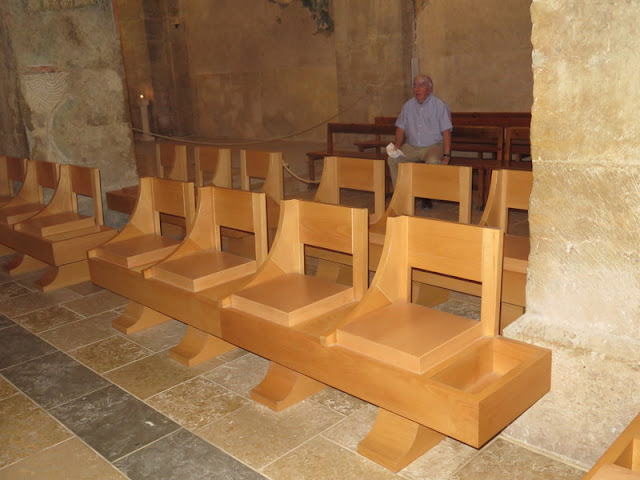The Benedictine Monastery is a well preserved Crusader remains in the country. This Gothic church was built in 1140 but was acquired by the French Government in 1899 and placed in the guardianship of French Benedictine Father. This hidden treasure is located at the heart of the Arab village of Abu Gosh near Jerusalem and near the Church of Our Lady of the Ark, from my previous post. The monastery belongs to the ancient Catholic order founded by Saint Benedict in Italy in the 6th century.
In 1873, the church was given to the French Republic and in 1900 a monastery was built next to the church by French Benedictine monks and in 1901 the Benedictine monks came to the Holy Land. We were met by a monk in brown robes when we entered the area of the monastery and church.
The courtyard of the church is lovely and consists of many gardens. The location is actually Emmaus, the town where Jesus and his disciples travelled through when leaving Jerusalem.
Luke 24:13-35 places the setting on the evening of the day of Jesus' resurrection. Cleopas, a follower of Jesus, and a companion were walking from Jerusalem to Emmaus, a distance of 7 miles, and as they were talking events of the past few days regarding Jesus' empty tomb that was found earlier that day, a stranger joined in their discussion. They did not recognize him and He rebuked them for their disbelief of that event and then explained prophecies about the Messiah to them.
When they reached Emmaus, they invited the stranger to join them for their evening meal. When He broke the bread, "their eyes were opened" and they recognized Him as the resurrected Christ but right then He vanished. Cleopas anxiously returned to Jerusalem to tell the other 11 disciples that Jesus was truly alive. While he described what he and his companion had experienced with the resurrected Christ, Jesus appeared to all who were there. He gave them a commission to spread the word and evangelize and took them out to Bethany (about 2 miles) where He blessed them before ascending back into heaven. Because of this event, this is why the church was built here.
There was a sweet little nun working outside in the garden. She was pruning some of the bushes and seemed to be focused on making the gardens beautiful.
In 1956, the property changed hands and has been run by the Lazarist Fathers ever since. Today both nuns and priests worship in the church and offer wonderful hospitality to all who visit. There is a small gift shop where we bought a small boat shaped bowl carved out of olive wood. All of the wood carvings we've seen in Israel have been of olive wood.
In the garden and in the walls of the church, there is a little spring that flows through it. According to Christian tradition, the spring was the biblical site of Kiryat Yearim. Kiryat Yearim is the place where the Ark of the Covenant was left when the Philistines returned it before being taken up to the Temple Mount. Remember when I talked about this in the previous post and we saw the Church of Our Lady?
According to the Bible, it is from this place that King David then carried the Ark of the Covenant to Jerusalem. (Samuel 2:6)and when he did, there was much rejoicing in song and dance.
The monastery's walls and columns feature lovely frescoes that were painted during the 13th century and are surprisingly preserved. In the church crypt, you can also see the walls the Crusaders built, some are as thick as 11.5 feet and a spring flows through the crypt.
The frescoes were damaged by humidity and by deliberate defacement when almost all of the faces were removed. They were painted by a Byzantine artist between 1150 and 1174.
The frescoes have been cleaned and restored as much as possible. Although the monastery is Catholic, the frescoes were done by Greek Orthodox artists in Byzantine style.
The crypt was built on two levels: the upper level where the chapel is and a lower level around a spring's overflow and also where people could gather privately to worship.
We assumed this must be a baptistry because there was water in the font.
While we were admiring the beautiful frescoes and sitting quietly, a group of tourists came in. Then three musicians
took their place in an area at the back of the sanctuary and played some hymn tunes on wooden flutes. The acoustics were wonderful and we enjoyed their music.
I wondered if there could be an organ here and after looking closely at a brightly painted cabinet, I discovered it housed a very small pipe organ and to the side I found a small console. If you look very closely in the left top corner, you will see some pipes of the organ. I would assume that because the doors of the cabinet are hinged, when the organ is played the doors would be opened to expose the pipes. I'll bet there is a fascinating history behind it.
The console was locked but if it had been open, I would have asked for permission to play it. It was powered by electricity.
The courtyard consists of 7.5 acres of gardens along with an orchard, olive and pine trees. Nine monks currently live in the monastery and 12 nuns live in the building next door. Most of their day is spent in religious study, prayer and working in the garden, as well as in the ceramic and candle factory on the premises. I am grateful that we have the opportunity to visit so many interesting places in Israel and to be able to walk in places that have so much history.






























All of the Abu Gosh posts are places we never visited. You have had some wonderful experiences there. We really enjoyed reading about their history, seeing the gardens, and cathedral interiors. Thanks for the great photos.
ReplyDeleteWow. Amazing.
ReplyDeletethanks for telling and showing such wonderful historical places
ReplyDeleteThey bring a feeling of reverence.